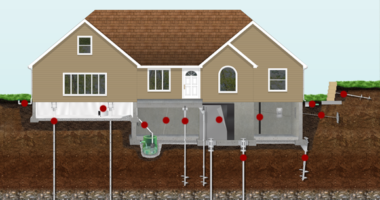There are a lot of good reasons to inspect your home for structural issues. If you’re considering selling in the next year or two, there’s a pretty good chance your home will require some work to meet modern building codes. But even if you aren’t planning on moving any time soon, there are still good reasons to consider an inspection. A quick survey can help you avoid nasty surprises like flooding and structural damage down the road. For more information on how to detect voids in your house’s foundation, see this article.
Check for sagging floors and ceilings
The next thing to do is to check for sagging floors and ceilings. The floor structure is one of the most important parts of a house; it supports the whole house and is the base for the walls and the ceiling. The floor structure is also the base of your house’s plumbing and electrical systems. To check for sagging floors, look at the edges of the flooring in each room. The edges of the flooring should be the same height, with no gaps or sags. If you see any sags, the floor needs repair.
Get a home inspection and only hire a professional for void filling if any
As you settle in a new home, have someone inspect the foundation. This is very important because it can save you a lot of money in the long run. It’s very common for older homes to have problems with their foundations. The most common problems include cracks and voids in the foundation. These problems are very easy to fix, but they are also expensive. You can save hundreds or thousands of dollars by having an inspector look at your home before you buy it.
Most homeowners think they can fill small voids themselves. This is the wrong approach. You can increase a foundation’s stability by filling small voids, but it’s best to hire a professional near you or get quality concrete void filling at Resinject if you have a large void.
A small void is a small hole in the concrete foundation, usually around the perimeter. The hole is usually filled with dirt or debris. It’s very common for these holes to be about the size of a quarter. If you have small voids, you can fill them using cement and sand mixture. Mix the two with water and use a paint roller to fill the voids.
Look for holes, cracks, and gaps around exterior walls
Finding a foundation void in the exterior is one of the easiest places to start when it comes to foundation repair. The holes, cracks, or gaps you find around exterior walls are all symptoms of a foundation problem. If you see cracks or gaps in the mortar between bricks, check the walls behind them for a void. Do you see a crack on the exterior wall? Run your hand along the crack; if you feel air behind it and it goes in further than the brick, you may have found a void.
Have a professional check for mold in your attic or walls
If you have wet spots on your roof, foul odors, or wood rot on your exterior, these could be signs of a leak. If you notice musty smells or find mold growing in your basement, crawl space, or attic, it could also be a sign that you have a leaky foundation.
When water collects in the walls or foundation of your home, it can do serious damage to your property. This can lead to mold growth and the need for extensive repairs. In order to avoid this, have a professional check your property for any problems. They can find any water leaks, water pooling, and moisture buildup, which are all signs of a possible mold problem.
Do a visual inspection of your basement walls, especially near windows and doors (if applicable)
If you’re looking for holes, cracks, and other visual signs of foundation problems, the best place to start is in the basement. Look at the walls and see if they appear to be sinking or pushing outward. Look for signs of water seepage or other dampness. Check for cracks, especially along window and door frames and around plumbing and electrical lines, if applicable.
Check the roof and see if it’s settled into the house
If your roof is settled into the house, you may have a gap between the house and the roof. This is called a “roof lean”. It may be caused by a structural defect in the house, like a lean-to addition or a poor foundation. If you have a lean, check to see if the exterior walls are moving. If they are, fix the lean-to, or remove the lean-to, and fill in the gap. If the exterior walls are not moving, check the crawl space.




